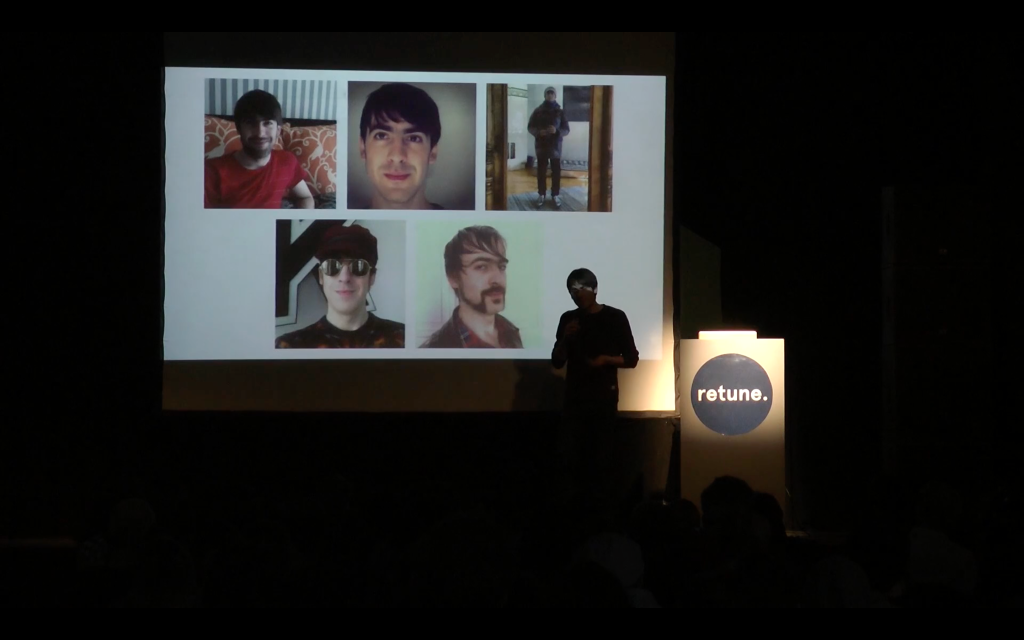AI Selfies are all the rage. Carousels of images depicting our friends in several style variations are commonplace. Critics have stepped forward. These algorithms have absorbed the work of artists without any sort of remunerations, royalties or credit. Course correction has been modest and superficial at best. These tools are rife with gendered, sexist, ableist, and racist biases. People are also concerned about a new wave of 21st century body dysmorphia. All these points of view are enriching to consider and debate. And there is a parallel narrative about the nature of identity that I would like to address.
In 2014 I gave a talk at the Retune art and technology conference in Berlin called “What is Hypercubist Identity?”. In point of fact, I gave four mini talks. I presented Faces of N., an audiovisual EP exploring identity through the lens of fashion.
I decided to use the opportunity to reflect my own facets of self. I initially appeared on stage calling myself a Director. Over the course of the talk, every time I showed a video from the series, I went backstage. When the video would end, I would return to stage in a new outfit, only to restart my talk again. Director gave way to Artist, Composer, and finally Theorist. In this way I embodied a holistic praxis of Hypercubist Identity.




We occupy an intersection of identities; it is foundational to the human condition. Gender, family, friendships, work, class, race, nationality, ethnicity, religion, ability, etc etc. When social platforms requires a 1:1 relationship between one email address and one user profile, an artificial singularity of identity is created where there is in fact a polysingularity.
So when we scroll into a friend’s explorations with AI and witness them depicted as an astronaut, an oil painting, or an anime character in short succession, what we are seeing is the aesthetic reification of an ontological truth that was there all along:
We are multitudes.
Our digital future will be richer or poorer as a coefficient of what degree this multiplicity is acknowledged, honoured, protected and allowed to flourish – or to what degree it is compressed. It may seem like news that a monolithic era of identity may be ending. But our trans, fluid and gender queer friends have known this fantasy of singular identity to be a myth for millennia. Now the masses are tasting this resonant aesthetic experience for the first time at scale. Consider how much easier it is to submit 20 photos to an AI than it might be to try on makeup or buy a wig and go out in public. And consider why many LGBTQIA+ influencers haven’t been the first to jump on the AI selfie bandwagon. This is something bigger than just Instagram fodder.
Let us use these AI tools to unblock our inhibitions and embrace our multiple Identities. And in the meantime, let us find our collaborators and champions. Let us find the people in our lives who can help us show up in the world in ways that reify our truly multidimensional selves. And let us acknowledge the craft and skill of professional image makers – and hire them when we can!
Waiter, there’s Bias and Extra Fingers in my AI.
I am reminded of the ancient practice of inserting trap streets into maps. Cartographers would include fictional roads as a mechanism for spotting plagiarism. When we see an AI generated image that prickles us we should take a beat. Yes, its doe-eyed buxom misogyny or a sixth finger may really bother us. This should be less sexist, this should be anatomically correct! But we can reframe. These biases and glitches are trap streets of a different kind.
Rather than warding off derivative works, these aspects signal they are derivative works! To be clear: we are not glad to see more bias or glitch in the world. But isn’t it a good thing that we can still tell the AI from the human? That, despite the huge leaps made in the last years, we can still preserve our discernment of the uncanny valley?
These tells may not last. The resolution will get higher. The sophistication of the simulation will increase. Soon enough the depth maps will enable us to just “reach into” the AI generated image and adjust what we see like a sculptor adjusting clay in a diorama. We’ll be able to execute complex object-oriented commands with natural language. Move the character to the left side of the table; tilt their head more to the right, dim the lights 30%, bring that character into the foreground, etc.
We should savour this moment of self awareness and reflect on it. Future generations will rely on our anecdotes and lived experience to preserve this prologue to the era of the hyperreal. They will gaze at us through the lenses of their XR eyewear. They may scoff at our nostalgia. They will have a hard time imagining it took more than a couple hastily issued voice commands to try out a different look.
And we will take them by the hands. And we will take them on field trips to the vintage stores. Open our makeup cabinets. Show them the wig shops and the backs of our dusty wardrobes. And we will share our embodied humanity with them. Lest they forget their bodies entirely, as the waves of simulated hyperreality crash against the shores of our collective consciousness.
